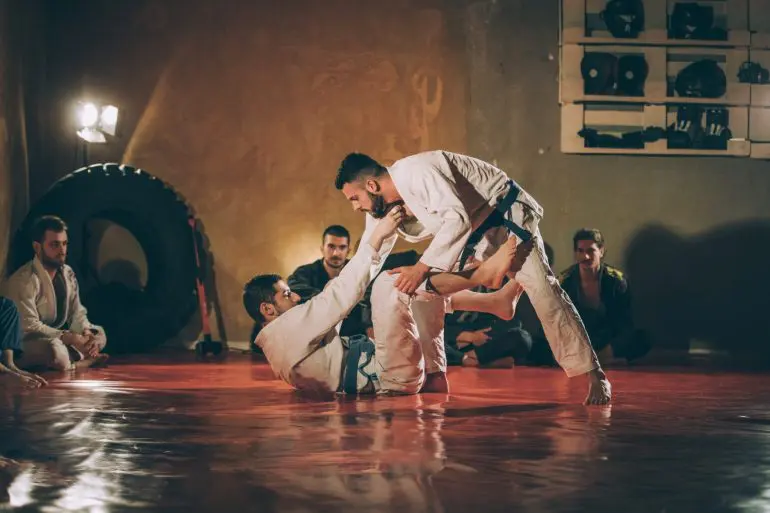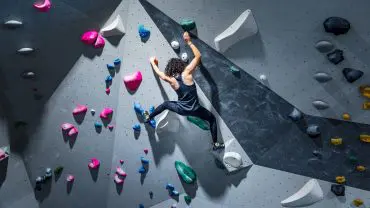Originally developed by Japanese samurai, the jujutsu martial art is a system of close combat focused on using an opponent’s momentum against them.
Yet jujutsu is also a sport, a grappling style and a form of self defence. It has launched a myriad of other martial arts, forming a category all of its own.
But what is jujutsu in practice? What techniques does it teach? And what are its underlying principles?
The History of the Jujutsu Martial Art

Practicing Japanese martial arts (Photo: Kilito Chan via Getty Images)
There are various claims as to the origins of the jujutsu martial art, with some tracing it back as far as the year 23 BC in the Yayoi period. Indeed, jujutsu has its roots inextricably tangled with the history of all Japanese martial arts, including sumo and Tegoi.
However, it was in 17th century feudal Japan that jujutsu was first coined as a term to encompass various forms of close combat, whether unarmed or with small weaponry. This occurred during the Edo period, when the warrior class, often known simply as samurai, developed it as an additional or alternative fighting style alongside their swordsman skills.
Jujutsu emphasised the neutralisation of one’s opponent, using an enemy’s force against them. It would in fact become a core aspect of samurai training and focused heavily on throws, locks, choking and immobilisation techniques as opposed to strikes, which were seen as inefficient.
Over time, various aspects contributed to the development of the jujutsu martial art, from who was in power, to prominent philosophies. Striking techniques began to be incorporated in the jujutsu schools in the 19th century and, in the Meiji period, jujutsu underwent reform to reduce injuries and fatalities. As part of this, teacher and martial artist Jigaro Kano developed a new form of jujutsu, known as judo. This focused primarily on self-defence and a philosophy of living harmoniously.
Judo and other forms of jujutsu were introduced to the west from the late 19th century, however it was in the latter half of the 20th century that they flourished there. The first international jujutsu governing body, the European Ju-Jitsu Federation, was formed in 1977, becoming the Ju-Jitsu International Federation (JJIF) in 1998. Today, the JJIF governs all sport versions of jujutsu.
What Does Jujutsu Mean?

Practicing Jujutsu moves (Photo: InkkStudios via Getty Images)
The first step in defining jujutsu is to examine the origins or etymology of the name. So, what does jujutsu mean? Well, it is made up of two Japanese characters. The first, “ju” (柔) can be translated to mean flexible, supple, yielding or versatile, but is most commonly seen as “gentle”. As for the character “jutsu” (術), this can mean practice, technique, or skill, but is usually translated as “art”. So the most common translation of the Japanese “jujutsu” is “gentle art”. It’s worth noting that, while jujutsu is the standard English spelling, various sources spell it jiu-jitsu, ju-jitsu or by other variations. It is also known by the name yawara.
What does Jujutsu Mean in Practice?

Jujutsu techniques (Photo: pedro arquero via Getty Images)
So, does “gentle art” adequately define jujutsu? Put another way, what is jujutsu in practice? Overall, jujutsu is usually seen as an umbrella term for Japanese martial arts that engage in close combat to defeat or subdue opponents.
Some would argue that this would include all martial arts originating in Japan, while others would restrict it to traditional schools, thus excluding more modern forms such as aikidō. What’s more, whilst often defined as a form of unarmed combat, it is perhaps best to say that jujutsu uses few, if any, minor weapons.
As for the “gentle” aspect of the art, this refers to the core principle of using an opponent’s force against them rather than meeting it with force. The idea is to unbalance one’s opponent before immobilising them. Some prefer to interpret the word as “flexible”, this being closer to the idea of harnessing an attacker’s force to defeat them.
Whilst this is all based on generally accepted principles, it can vary depending on the teachings and styles of individual schools or “ryu”.
The matter of “what does jujutsu mean” is further complicated by the distinction between the jujutsu martial art, as summarised above, and three other forms it commonly takes, namely as a form of self-defence, as a type of grappling – usually called Brazilian Jiu-Jitsu – and as a sport.
Sport jujutsu is governed by the Ju-Jitsu International Federation (JJIF). Sport jujutsu is covered below, but the JJIF also has its own definition of jujutsu as:
- Any physical action used to defend oneself against any unwanted, unprovoked and/or unlawful attack.
- Such attack can be armed or unarmed and range from a push to a punch and beyond.
- Defence techniques can include evasion, releases, locks, throws, controlling moves, strikes and blocks.
- The defender must always act lawfully, fairly and proportionately to the nature and imminence of the attack, with the utmost goals of stopping the attack while protecting property and people, minimising any injuries.
Jujutsu Martial Art Techniques

Jujutsu Training Class (Photo: South_agency via Getty Images)
The jujutsu martial art uses a variety of techniques for both attack and defence, including grappling, throws, thrusts, holds, blocks, chokes and joint locks. And, while traditional jujutsu did not really include strikes, it developed to incorporate them.
These can include punches, kicks, kneeing and hits of various kinds. Furthermore, jujutsu teaches how to use the hard parts of one’s body, such as the fists, elbows and knees, to target an opponent’s vulnerable areas.
In terms of defence, jujutsu teaches various blocks, parries and evasions as well as the best ways to fall and release oneself from an opponent’s hold.
As mentioned earlier, jujutsu is usually practised unarmed. However, where weapons are used, these are small and can include knives (tanto), weighted chains (ryofundo kusari), bankokuchoki knuckle dusters or truncheons known as jutte.
Underpinning all of this is the concept of using an aggressor’s energy, weight and force against them. This can mean pulling when one’s opponent pushes or using their momentum to unbalance them. In some cases, it’s about leverage. And it places technique above brute strength.
What is Jujutsu’s Belt Ranking System

Multicoloured belts for grading (Photo: Georgiy Datsenko / EyeEm via Getty Images)
According to the JJIF, the jujutsu belt ranking system progresses as follows:
Children:
- Grey
- Yellow (min. Age 7)
- Orange (min. Age 10)
- Green (min. Age 13)
This includes a stripes system based on the number of lessons taken.
Adults:
- White
- Blue (min. Age 16)
- Purple (min. Age 16)
- Brown (min. Age 18)
- Black (min. Age 19)
Types of Jujutsu

Two men practicing Brazilian Jujutsu (Photo: Kilito Chan via Getty Images)
There are many different – think hundreds or even thousands – styles of jujutsu, each with its own unique focus and techniques. The traditional form of jujutsu martial art is often termed Japanese jujutsu to distinguish it from other styles. Two of the most popular styles include Judo and Brazilian Jiu-Jitsu.
What Is Jujutsu v Judo
Judo developed as the modern sports equivalent of the jujutsu martial art. While both judo and jujutsu focus on using an opponent’s momentum against them, judo focuses more on the competitive element and is an Olympic sport.
What Is Jujutsu v Brazilian Jiu-Jitsu
One of the biggest differences between Jujutsu and Brazilian Jiu-Jitsu is the focus on striking. In jujutsu, strikes are used to set up throws and joint locks, while in Brazilian Jiu-Jitsu, strikes are generally not used at all. What’s more, while jujutsu is based in self-defence, Brazilian Jiu-Jitsu is a grappling-based sport that emphasises ground fighting.
What Does Jujutsu Mean as a Sport?

Jujutsu Fighters practicing (Photo: South_agency via Getty Images)
Although there are many competitions and styles, the JJIF currently recognises three types of sport jujutsu.
- Duo: This is a demonstration of self-defence techniques by two members of the same team.
- Fighting System: In this format, opponents combat one another with various techniques including strikes, grappling and submissions.
- Japanese / Ne Waza: This is a purely grappling sport where opponents begin in standing positions and aim to make the other submit. Striking is banned in this sport.
In the words of Kano Jigoro, where there is effort, there is accomplishment. As for us, we have accomplished learning the answers to “what is jujutsu” including “what does jujutsu mean”, from the origins of the jujutsu martial art to its modern counterparts.











